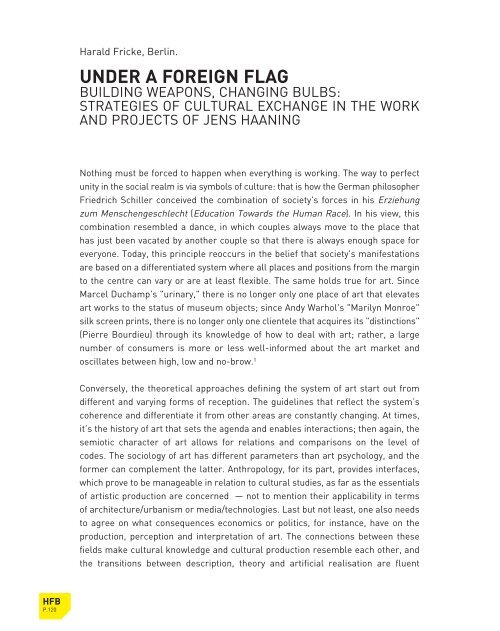download catalogue high resolution pdf (22.3 mb) - Jens Haaning
download catalogue high resolution pdf (22.3 mb) - Jens Haaning
download catalogue high resolution pdf (22.3 mb) - Jens Haaning
Create successful ePaper yourself
Turn your PDF publications into a flip-book with our unique Google optimized e-Paper software.
HFB<br />
P.120<br />
Harald Fricke, Berlin.<br />
UNDER A FOREIGN FLAG<br />
BUILDING WEAPONS, CHANGING BULBS:<br />
STRATEGIES OF CULTURAL EXCHANGE IN THE WORK<br />
AND PROJECTS OF JENS HAANING<br />
Nothing must be forced to happen when everything is working. The way to perfect<br />
unity in the social realm is via sy<strong>mb</strong>ols of culture: that is how the German philosopher<br />
Friedrich Schiller conceived the co<strong>mb</strong>ination of society's forces in his Erziehung<br />
zum Menschengeschlecht (Education Towards the Human Race). In his view, this<br />
co<strong>mb</strong>ination rese<strong>mb</strong>led a dance, in which couples always move to the place that<br />
has just been vacated by another couple so that there is always enough space for<br />
everyone. Today, this principle reoccurs in the belief that society's manifestations<br />
are based on a differentiated system where all places and positions from the margin<br />
to the centre can vary or are at least flexible. The same holds true for art. Since<br />
Marcel Duchamp's "urinary," there is no longer only one place of art that elevates<br />
art works to the status of museum objects; since Andy Warhol's "Marilyn Monroe"<br />
silk screen prints, there is no longer only one clientele that acquires its "distinctions"<br />
(Pierre Bourdieu) through its knowledge of how to deal with art; rather, a large<br />
nu<strong>mb</strong>er of consumers is more or less well-informed about the art market and<br />
oscillates between <strong>high</strong>, low and no-brow. 1<br />
Conversely, the theoretical approaches defining the system of art start out from<br />
different and varying forms of reception. The guidelines that reflect the system’s<br />
coherence and differentiate it from other areas are constantly changing. At times,<br />
it’s the history of art that sets the agenda and enables interactions; then again, the<br />
semiotic character of art allows for relations and comparisons on the level of<br />
codes. The sociology of art has different parameters than art psychology, and the<br />
former can complement the latter. Anthropology, for its part, provides interfaces,<br />
which prove to be manageable in relation to cultural studies, as far as the essentials<br />
of artistic production are concerned — not to mention their applicability in terms<br />
of architecture/urbanism or media/technologies. Last but not least, one also needs<br />
to agree on what consequences economics or politics, for instance, have on the<br />
production, perception and interpretation of art. The connections between these<br />
fields make cultural knowledge and cultural production rese<strong>mb</strong>le each other, and<br />
the transitions between description, theory and artificial realisation are fluent


